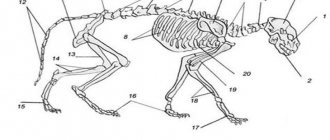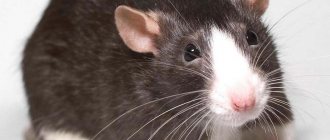Beautiful ears on a dog
– this is the merit of the owners. With cropped ears, dogs look beautiful and impressive. Veterinarians professionally crop dogs’ ears and tails from 2 months of age. We have a variety of patterns for all breeds.
Veterinarians come to homes to crop ears for puppies in Moscow and the Moscow region, without holidays or weekends.
It is better for small puppies to do this procedure at home in order to avoid complications and infections after visiting veterinary clinics.
What is ear cropping in dogs?
Cupping is a partial or complete amputation of the ears. The length left depends on the standard assigned to the particular breed.
This operation began with the ancient Romans and Greeks, who shortened the ears of fighting and hunting dogs for safety purposes. Short ears were more difficult to grab with teeth or scratch with bushes. Amputation also reduced the risk of infection by mites and reduced the likelihood of inflammation due to insufficient ventilation of the ear canal.
Doberman
It was not nature that gave the Doberman long pointed ears; removing the loose soft part helps give them the desired shape. The standard provides for such an operation to obtain an invulnerable service dog. This is what the creator of the breed, Louis Doberman, wanted.
The procedure simplifies the care of the pet, makes it more intimidating, and eliminates the risk of injury in service. Ear cropping protects against rabies and reduces the risk of ear inflammation.
The optimal age of a puppy for surgery is 6-7 weeks. Approximately 2/5 of the shell area is cut off, taking into account the size of the head to achieve harmony. Correct ear position is guaranteed by bandages and clamps.
Feasibility of the procedure
Since the 20th century, most European countries have opposed the operation, banning it at the national level by signing a convention. Changes have been made to the established conformation of many breeds, easing the rules for taking part in a dog show. The natural shape of the ears was no longer a serious obstacle to receiving an honorary title, so the only argument in favor of amputation remained only medical indications.
Exterior of the breed
Folding ears have always been associated with good nature. Such a soft image does not fit at all with the Doberman and other fighting breeds. For this reason, proponents of cupping continue to support its appropriateness, citing aesthetics.
Health recommendations
Due to insufficient ear ventilation, fold-eared breeds often suffer from otitis media. These dogs have their ears cropped for preventive purposes. Surgery is also used in the presence of the following medical indications:
- multiple ulcerations that prevent self-regeneration of the skin;
- burns and mechanical injuries;
- necrotic formations;
- tumors.
Relaxations are also made for those who perform guard duty or help their master on the hunt. In addition to protecting against parasites and infections, short erect ears are much better at picking up sounds. This makes it easier to catch violators and chase prey.
Arguments against
Animal rights activists focus on the dangers of anesthesia, the painfulness of the procedure and possible complications characteristic of any surgical intervention. No less important is the partial loss of the means of communication, since locators on the head participate in the communication process along with the tail.
If you nevertheless decide to amputate for the sake of preserving the historically established exterior, make sure that your actions are legal. In some countries, cropped ears can be a serious reason for refusing to participate in an exhibition.
Pit bull terrier
The breed was bred for dog fighting. Today this is a rare occurrence, and the strongly built animals live in peace with humans.
Puppies are docked at the age of 1-2 weeks, usually leaving 1/3 of the original length of the ear. The fighting form has short shells, the exhibition form is very characteristic, with a corner bent inward.
The operation prevents ear necrosis, ulcers, injuries and neoplasms in pit bulls.
What breeds need the procedure?
According to international standards, amputation is recommended for almost all working, hunting and fighting breeds. The main condition is that the ears are too long, unable to stand on their own from birth.
List of breeds
The most famous representatives include:
- miniature pinschers;
- American Staffordshire Terriers;
- alabai;
- Caucasian Shepherd Dogs;
- Cane Corso;
- pit bull terriers;
- boxers;
- Dobermans;
- Great Danes;
- toy terriers.
The recommended length and subsequent placement of cropped ears are different for these dogs. For this reason, it is very important to find an experienced veterinarian who is aware of all the nuances.
Features of cupping for each of them
Let's consider the main features of amputation for each of the previously listed breeds:
- miniature pinschers
. This miniature version of the Doberman is a decorative breed, so docking is used solely from an aesthetic point of view. It is carried out at 3 months. After removing the sutures, they resort to mandatory fixation with cotton swabs.
- American
Staffordshire Terriers
. Amstaffs are circumcised at 1.5-3 months, choosing the length depending on the animal’s field of activity. The maximum length is reserved for show pets, and the minimum length for working dogs. Amputated ears easily take the desired shape without an additional frame. - Alabai
. Representatives of this breed often suffer from heavy blood loss, so they are operated on within 3 days after birth. The shape is selected to be as short as possible, that is, no more than 1/3 of cartilage.
- Caucasian
Shepherd Dogs
. The recommended timing and form are similar to Alabai. Later intervention is not recommended, since manipulation of the hardened tissue often leads to complications. - Cane-Corso
. Using the procedure, hanging ears are turned into neat rounded triangles. They stand up very well on their own, but for reliability they are still fixed with adhesive tape.
- Pit bull terriers
. The methodology and recommended age are similar to amstaffs. It is better to sign up for surgery 2 weeks after vaccination.
- Boxers
. The final shape resembles horns, and the recommended age is 2 months.
- Dobermans
. Here it is recommended to do it before the onset of 2 months, that is, before the change of baby teeth. Only 2/5 of the animal’s ears are cut off, making sure to secure the shell with clamps and bandages.
- Great Danes
. Dogs are registered for docking at 2.5-4 months. They cut off 1.5-3 cm of the ear tissue and fix it all using a structure for Dobermans. The only difference is the size of the materials used.
- Toy Terriers
. Another decorative dog undergoing the procedure solely for aesthetic purposes. They are docked at 2 months, be sure to secure the cropped ears with a tight bandage for proper placement.
Despite some age differences, there is a limit that is the same for everyone - 4-6 months. We are talking about the upper limit when cutting becomes very painful due to the development of pain memory.
Boxers
There are no such dogs with floppy ears in nature. Docking for a boxer is not a whim, but a vital necessity.
This breed can have ears of different shapes and sizes. The situation is the same with thickness and density, positioning and turning. In any case, the ears should be in harmony with the Boxer's head.
The best age for surgery is 2.5-3.5 months. The standard provides for a sharp shape of the ears.
Until what age do dogs have their ears cropped?
The easiest time to undergo the operation is shortly after birth. Up to 2 weeks, babies are less sensitive to pain and do not remember it, and their tissues regenerate much faster. The only negative is increased bleeding.
After 4-6 months, the pain worsens, and large scars often remain at the site of circumcision. For this reason, the average age for ear cropping in dogs ranges from 2 weeks after birth to 3 months, and the maximum is 4-6 months. At a later age, amputation is resorted to only for medical reasons.
Veterinarians' opinion
Olga M.:
“As for modern decorative indoor show dogs, docking their ears and tails does not have any serious argument, it is simply ridiculous and absurd.”
Anna P.:
“Remember that a dog’s tail is not skin, but part of the spine! And cutting off the tail means breaking a lot of nerves, which inevitably leads to severe pain and probably phantom pain after surgery."
Progress of the procedure step by step
The animal is operated on in a veterinary clinic or directly at home. Despite the attractiveness of the latter method, it is better not to resort to it. At home, it is more difficult to maintain sterility and provide first aid in case of complications.
The duration of the procedure takes 30-60 minutes. To crop dogs' ears, a pattern is used - a metal stencil that matches the required shape.
immediate docking begins
- The pattern is fixed to the shells using clamps to prevent bleeding.
- The excess part of the ear tissue is cut off with a scalpel. If there are large blood vessels, the edges of the wound are cauterized.
- The operated part is sutured, treated with antibiotics and a special healing glue.
The awakened pet is returned to the owner. The postoperative period lasts 7-10 days.
Advantages and disadvantages
Any action has its advantages and disadvantages. The cupping procedure is no exception. Supporters of tail and ear trimming actively convince of its benefits and even necessity. Most often this can be heard from owners of hunting and fighting dog breeds, such as:
- schnauzers;
- Great Dane;
- Doberman;
- Staffordshire Terrier;
- pit bull terrier;
- Caucasian Shepherd Dog.
These breeds most often have their ears trimmed, since the soft, drooping part contains many nerve endings and in case of injury or damage, the dog may experience severe pain, shock, and severe blood loss is also possible. It is also believed that cropped ears are less susceptible to infections and diseases than floppy ears.
Tails are cut:
- boxers;
- Rottweilers;
- Cane Corso;
- schnauzers (Zwerg, Mittel, Risen);
- Dobermans;
- Yorkshire terriers.
These are hunting and fighting breeds of dogs that are often injured during exercise by hitting hard objects. A short tail also helps the owner remove them from the hole and prevents injury from a predator.
The opponents' arguments are simple:
- the procedure has long lost its practical necessity for most breeds;
- this is intentional harm to the health of the dog;
- Circumcision disrupts the natural process of development of the puppy, inhibits growth, affects orientation in space, and deprives the opportunity to fully “communicate” with humans and relatives.
Everything that is given by nature is for a reason. Why a dog needs a tail can be read in more detail in this article.
Caring for the animal after surgery
After cropping, the dog's ears are tightly bandaged, making correct positioning easier. A veterinary cone is used to protect against injury. Until the wounds heal, it is necessary to ensure that they are clean and the edges are dry. Otherwise, suppuration or deformation of the ears may occur.
Posting is done only after the stitches are removed. To do this, use a special massage and fixing structures made of cotton swabs and adhesive tape. While wearing such a corset, the ears gradually take the desired shape. Most often, production takes 14-20 days.
Schnauzers
The German tradition in relation to wire-haired schnauzers has always rejected lack of composure, promoted harmony and balance, and affirmed a clearly defined silhouette of the head and a “brick-shaped” muzzle. Ear cropping helped achieve such standards.
The correct operation creates an image chopped with an ax and gives a stern and wary appearance to this service breed. The procedure is carried out until the child reaches one year of age. After docking, the ears must be exposed.
Possible complications
Complications do not always occur due to poor surgeon performance and careless postoperative care. Often the individual characteristics of the animal are to blame for their appearance. Possible consequences include:
- bleeding, fraught with heavy blood loss;
- large scarring that worsens the appearance of the ear;
- wound infection and subsequent inflammation, requiring repeated surgery.
If your dog’s health worsens, be sure to contact the veterinarian who performed the amputation. Remember that taking medications without a doctor's prescription is strictly prohibited.
Is it possible to perform ear trimming at home?
Pruning is done strictly by a veterinarian. Carrying out the procedure by a person without the appropriate education can result in the death of the animal from excessive blood loss, incorrectly selected anesthesia, or sepsis due to insufficient disinfection.
Calling a surgeon to your home is possible, but it also carries a number of risks. To be safe, it is recommended to neglect the psychological comfort of the animal in a familiar environment and carry out the operation according to all the rules - in the clinic.
Approximate cost of the operation
The average price ranges from 300 to 1500 rubles. The final cost depends on the city, the prestige of the clinic, the level of qualifications of the veterinarian, the age of the pet, the complexity of the case and the need for a home visit.
Conclusion
It is necessary to crop a dog's ears with great care, since saving on this procedure can result in the death of the animal. If you do not plan to participate in exhibitions and breeding, then it is better to accept your pet as it is. Droopy ears will not affect behavior and other important qualities, so you should not tempt fate to conform to an ideal that has long lost its relevance.
The article is for informational purposes only. Contact your veterinarian!
Do you like the article? 420
Briefly about the main thing
- The history of dog docking dates back centuries BC.
- It is a myth that puppies do not experience pain during docking.
- In many countries the procedure is prohibited.
- People's opinions on this matter are very mixed, but veterinarians do not recommend docking.
Have we answered your question fully enough? If not, write your question in the comments below and our specialist will answer it.
Did you like the article? Share it with your friends on social media. networks. This will help them get useful information and support our project.











